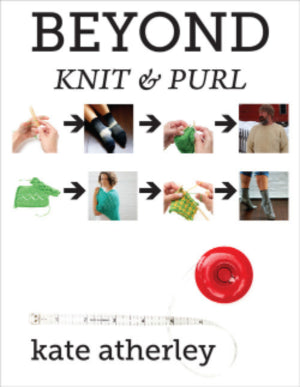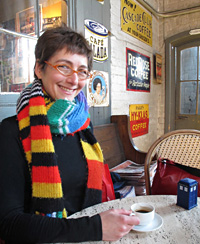**************************************
 |
| These socks are too big... no slouch allowed! |
It's good to have knitters of all levels test a pattern, both experienced and newer - they see very different things. It's often the 'simplest' questions that are the smartest, the ones that get to the key issues. Sometimes the experienced knitters are 'too smart' in that they make assumptions, and fix things without even thinking about it. Newer sock knitters don't have much experience to rely on, so they look at the instructions more closely - they ask excellent questions.
Recently, I've had a bunch of related question come back to me, and they all start like this: the sock doesn't fit.
I always reply in the same way: How big is your foot? What size did you make? And why did you choose that size?
The answers have all been very revealing, and I've learned a lot. I think the key thing I've realized is that sock sizing isn't as well understood as I thought it was.
So, without further ado, a quick primer on sock fit and sizing.
Key fact #1: Size Matters One size fits all just doesn't. There's about a 25% difference in foot length and circumference between the average "smallest" and "largest" women's feet. That is, a a woman's US shoe size 11/UK women's size 9.5/EUR size 44 foot is going to be about 25% bigger than a woman's US shoe size 5/UK women's size 3.5/EUR size 36 foot. The idea that the same size sock will fit that foot equally well is just plain false. (The same is true for the "average" range of men's feet.)
Key fact #2: Socks should be worn with negative ease That is, they should be smaller than the foot (and leg) they are to go on. You want the sock to stretch to fit. A sock that stretches to fit will stay up on your leg, and stay in place on your foot. A common problem cited with hand-knit socks is that the legs don’t stay up: in many cases, this is simply because the sock is made too big. (The sock in the picture above suffers from that problem; look at the left one. It's wrinkly and baggy.)
A hand-knit sock (especially those made out of wool or other animal fibers) will stretch out over the day, and you don’t want it to be so floppy that it falls off. And a sock that stretches to fit will stay put on your foot; socks that move around in your shoes wear out faster, and be much less comfortable, due to the friction.
For an adult foot, the finished sock should be about 10% (practically speaking, about an inch/2.5cm) smaller than the leg and foot in circumference, and about half an inch/1cm shorter in length. For a child’s foot, you want the sock to be about 10% smaller in circumference (e.g. half an inch/1cm for a foot with a 5 inch/12cm circumference), and about a quarter to half an inch/.5-1cm shorter in length.
Key fact #2: When choosing a sock pattern, choose the size you're going to knit by finished sock circumference (This is sometimes listed as "actual".) Measure yourself around the ball of your foot, and choose a size that will result in a sock that's about an inch or so smaller than that.
Related point a) When we say "size" in a pattern, it's identifying the person who should be wearing the piece - e.g. small/medium/large; it's "Finished" or "Actual" that identifies the size of the item in question. With a garment, we typically expect positive ease - that is, that the finished sweater will be a bit bigger than the person, so that for a 40 inch chest, you might make a garment with a 44 inch finished chest circumference.
Related point b) The term "ease" here means the difference between the size of the person wearing the thing, and the size of the thing. If the thing is smaller, then we say it's worn with negative ease. If the thing is bigger, it's worn with positive ease. If the thing is the same size, it's worn with zero ease.)Now, what happens if the sock doesn't give you finished/actual circumferences? Not to be a total curmudgeon, but I'd suggest those patterns should be avoided. How do you know what's going to fit you if it won't tell you what size you're making?
(That having been said, you can sometimes work it out... if you've got the gauge of the pattern stitch used for the foot/leg, and you know the stitch counts, then divide the number of stitches in the foot/leg by stitches per inch, and that's your finished size.)
What if it's sized by foot length?
I'll be honest: I don't like this one bit. For conventional sock constructions, setting the foot length of a sock is simply a matter of "work until it's the required length". The key measurement for sock fit is foot circumference, as that sets the number of stitches for the leg and the foot. There are short wide feet and there are long narrow feet. You can't really draw conclusions about foot circumference based on foot length - that's just not safe or reasonable.
If the sock sizes are given as "to fit", or by shoe size only, without finished measurements (and you can't calculate it easily), then it's going to be a bit of a guessing game... you can hope that the designer has done his/her homework on how to fit. Tread carefully.
If the sock sizes as given as "small", "medium", "large", or "child", "woman", "man" - again, tread carefully. If there's no finished measurements (or you can't work them out), avoid. (And again, I don't believe in one-size-fits-all, even if its "just" for a gender. As above, there's still a massive difference between a woman's small foot and a woman's large foot.)
And if there's only one size? If you can find/calculate finished size info, and it's the right measurement for you, to fit your foot, congratulations! Otherwise, move along. That pattern won't work for you.
Related point C) You'll notice that all of my published sock designs come in multiple sizes. You can see why.Remember, knitting socks is a fair bit of work - what's the point in spending all that time if they don't fit?
Questions? Issues? Concerns? I'm actually writing more on this topic now. If I can help clarify anything, let me know!
An excellent question: is negative ease "built in" to the pattern? Ooh... yeah... this is interesting. I think there's a lot of misunderstanding even with designers about how to express sizes. It's actually very simple: you MUST GIVE Finished Measurements - the measurements of the item when knitting. It's best when a pattern that has both "to fit" and "finished" so that I know how the designer expects me to wear an item; either that, or "finished measurements" and a statement about how to wear it, e.g. "sock should be worn with about an inch of negative ease". You can't "build" ease into a measurement. Measurements are absolute. Either they are the finished item, or they are the size of the person you expect to wear them. If I see something that states that "ease is built into" the measurements, I'm both confused and nervous about it...






7 comments:
and that, Kate, is why I took your custom sock class - to better understand how to make the sock fit the foot. Thanks again.
Negative ease? I've been making socks based on the "finished" measurement and sure 'buff my socks are a bit loose. Tx for the tip! What would you suggest for someone who has "athletic" calves but skinny ankles?
This is exactly the information I was looking for when I typed "how do I know if my hand knit socks are going to fit?" into Google! As a new sock knitter it's extremely important to me that all my hard work results in socks that fits!!
Now I feel much more confident that will happen.
Also, your explanation of ease is terrific. Thanks for sharing your experience and knowledge!
Can't believe how much sense this makes, now that you've explained it so well, of course! Had me completely stumped. l couldn't even begin to guess what, "negative ease" could mean. Thank you so much for a great explanation and for answering a few questions l wouldn't have known l needed to ask until it was too late. (:
Thanks for this. I really answers my question about negative ease before I start a special pair of socks with expensive yarn.
Hello Kate,
I was wondering, how do you measure the sock - laying flat (i.e. relaxed/unstretched)? What if it isn't stocking stitch?
Cheers, Sarah
Sarah/Kushami:
I hope you see this reply! I can't figure out how to get in touch. If you're talking about length, it's best to measure the sock on the actual foot. Otherwise measure it laying flat, unstretched.
If you need more info, drop me a note through my website http://kateatherley.com/contact-me/
Kate
Post a Comment